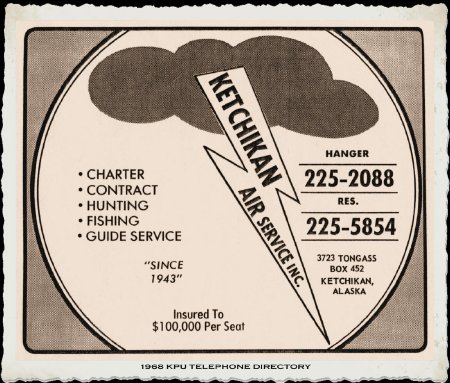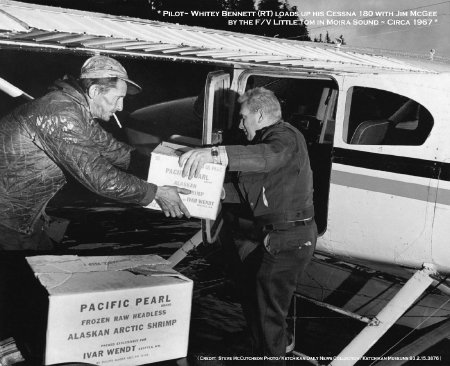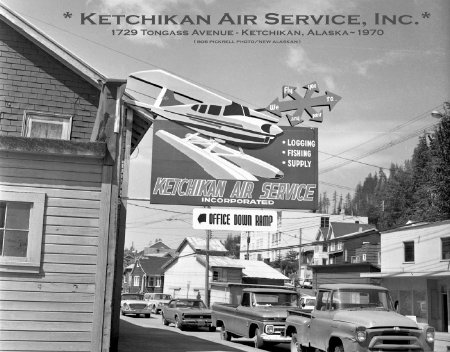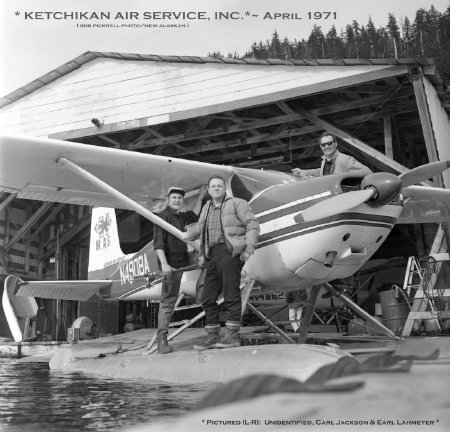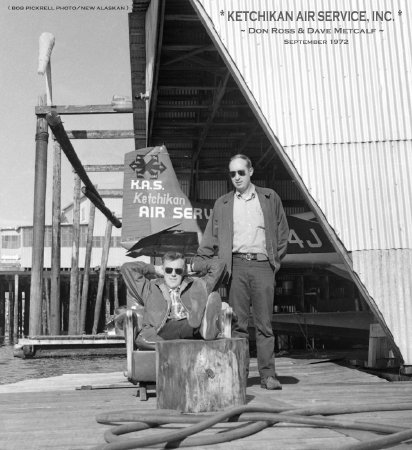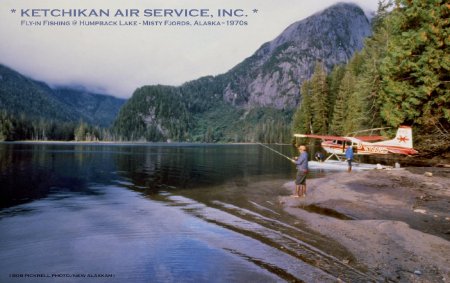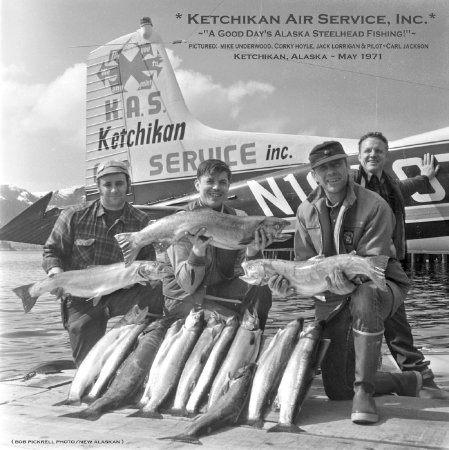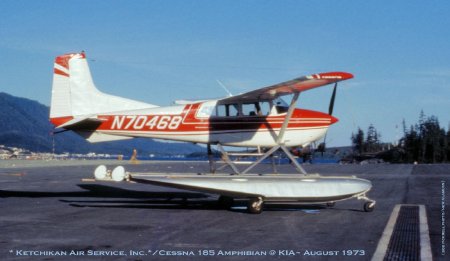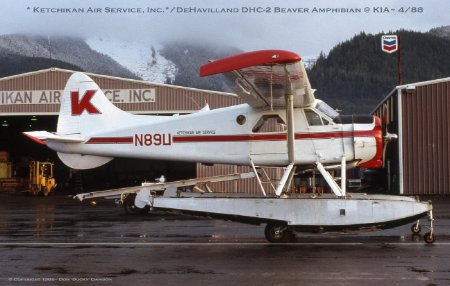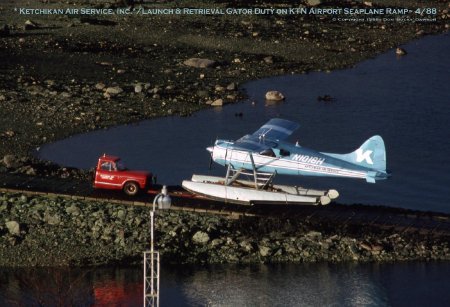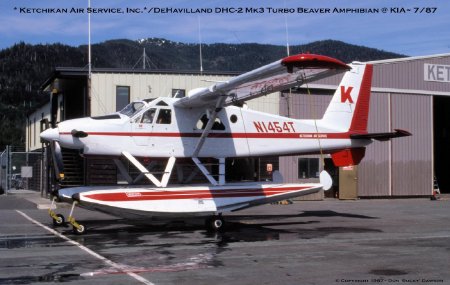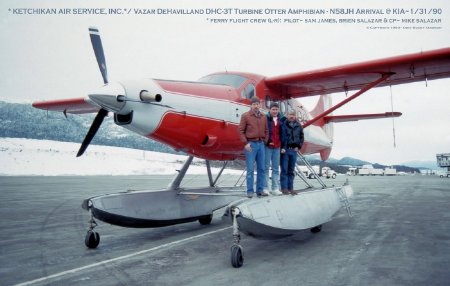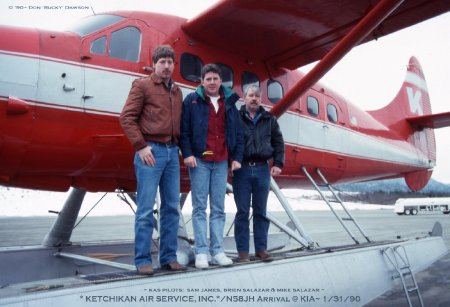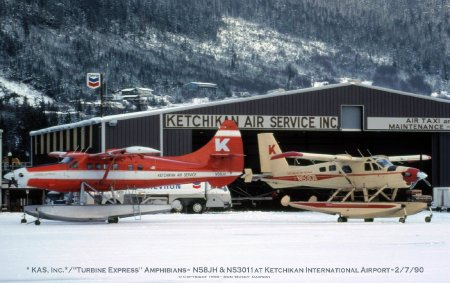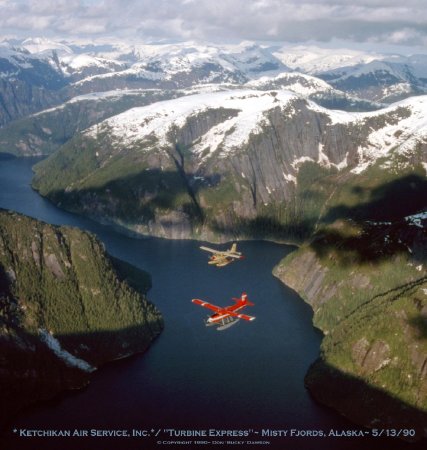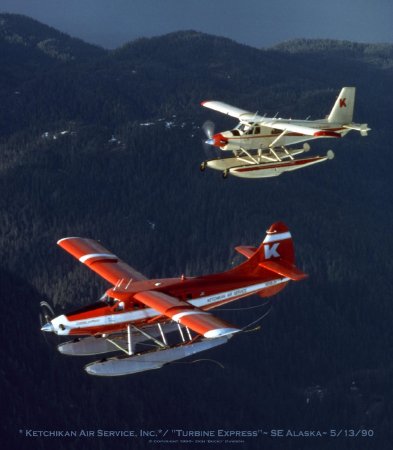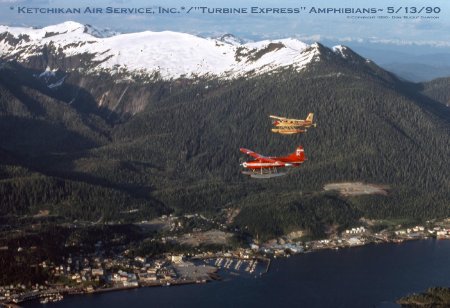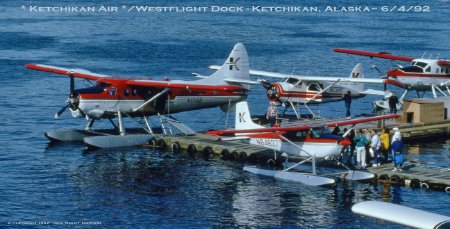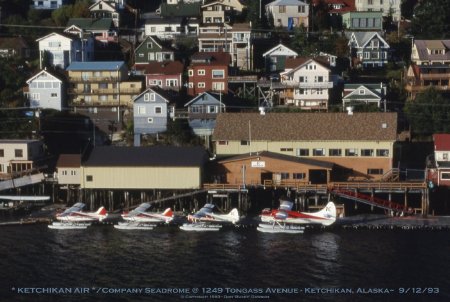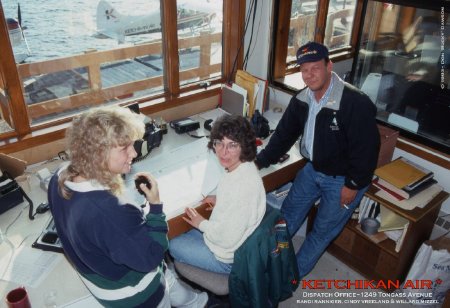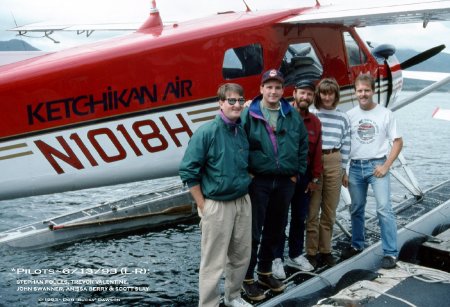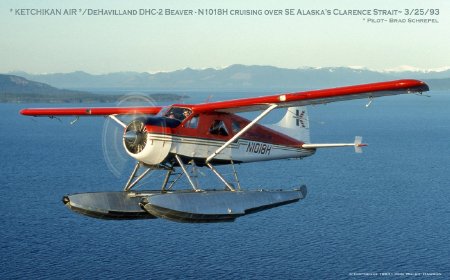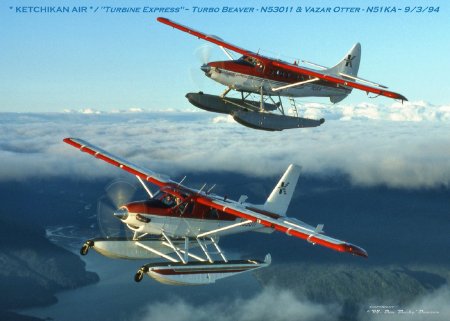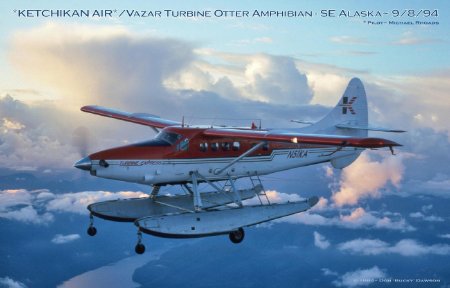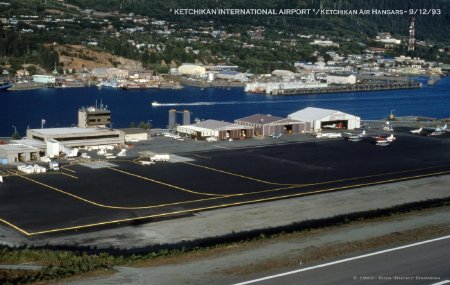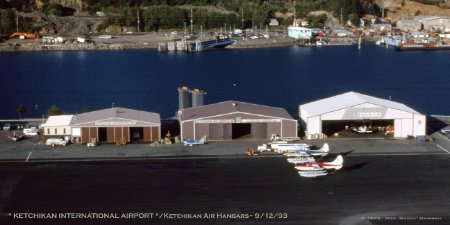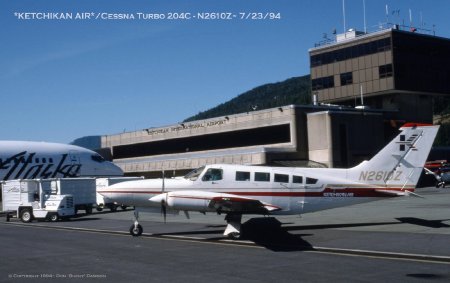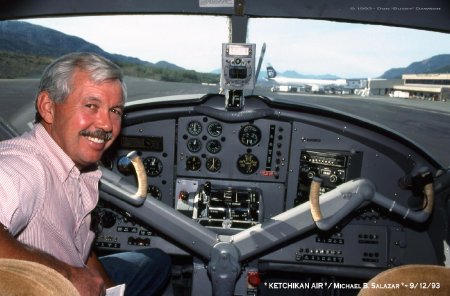Description:
Ketchikan Air Service, 1966-1997
Founded in 1966 by sole owner/pilot Edwin L. "Whitey" Bennett, using a single Cessna 180, the company's original first office and hangar located at 3723 Tongass Avenue (site of today's Vigor Shipyard). Bennett incorporated the company on November 6, 1966. There is no connection with the original Ketchikan Air Service previously operated by Stan Oaksmith, Jr., despite advertisement claims made by Bennett. In the summer of 1970, the Ketchikan Air Service, Inc. operating certificate was purchased from Bennett's ex-wife Brazilla, by a three-way partnership of local pilots: Don Ross, Carl "Red" Jackson, and Earl Lahmeyer. Their new waterfront office and hangar location was established closer to downtown at 1729 Tongass Avenue, which was previously occupied by Webber Air, Inc. The Cessna 180 seaplane N4908A is thought to be the initial aircraft used by the partners at the time of their startup (possibly brought in by Lahmeyer). A Cessna 185 (N70085) was soon added.
The dynamics of running new businesses with multiple partners is always challenging, while seeking stability for achieving a successful longevity, and such proved to be the case for this air taxi outfit. Red Jackson flew as a pilot for Ketchikan Air for about a year and a half, and then sold out his share and quit to go fly for Cotton Odell at Revilla Flying Service, which he later purchased in February 1972. Earl Lahmeyer followed suit next to leave Ketchikan Air Service. Then Dave Metcalf subsequently joined up with Don Ross, followed by Mike Salazar, to resume the three-way partnership arrangement for a time, until Metcalf sold out to Ross and Salazar. The two owner/pilots were a good pairing and the company thrived. Eventually Mike Salazar became sole owner of the company, after Ross finally retired on December 31, 1986 and sold out his shares.
Back in April 1973, anticipating the completion of the new Ketchikan International Airport on nearby Gravina Island, set to open in August of that year, Ketchikan Air Service acquired another Cessna 185 (N70468) that was fitted with amphibious floats in Seattle to use for runway operations in Ketchikan. Terry Wills, who had been partners with the late Carl Jackson and others in the Misty Fjords Resort/Humpback Lake Chalet, joined the pilot roster that September. In 1975, the growing company built its first airport hangar, which was 8,000 square feet, offering fuel and Cessna aircraft sales, parts, and maintenance. An additional 4,800 square feet was added for their main office and additional rental offices. By 1976, Ketchikan Air Service moved to its new location at 1600 Airport Terminal Building. In 1979, a larger second hangar was built to accommodate additional aircraft maintenance and storage. Flight instruction was also offered. As Ketchikan Air Service's Southeast Alaska route destinations expanded, a twin-engine Piper PA-23 Turbo Aztec wheel plane was added to the fleet to supplement the company's growing fleet of amphibians and seaplanes.
Fateful circumstances transpired on August 12, 1987, when a tragic mid-air accident occurred over town on August 12, 1987. Ketchikan Air Service Cessna 185E amphibian (N73WS), flown by Mike Salazar with two passengers aboard, collided over the Tongass Narrows with an inbound Temsco Helicopters Hughes 500 (N58318), resulting in the loss of veteran local chopper pilot Ralph Yetka and his passenger. FAA repercussions forced discontinuing the practice of using the airport taxiway for takeoffs, and establishing more rigidly defined air traffic flight patterns for the immediate Ketchikan area.
In the late 1980s through December 1992, Ketchikan Air Service reestablished a downtown waterfront location by leasing office and aircraft dock space at the Westflight Building at 1621 Tongass Avenue. In November 1988, Ketchikan Air Service also used the Promech floating hangar next door (previously the Revilla Flying Service hangar) for a couple years. Alaska's burgeoning tourism industry was becoming a major economic factor in aviation marketing strategies. Starting in the 1990s, cruise ship lines began increasing their focus on seasonal sailings into Southeast Alaska's Inside Passage. Flightseeing trips to Ketchikan's Misty Fjords have long been a prime popular local tour attraction. Air taxi companies compete heavily for a piece of the pie; augmenting their airplane fleets to accommodate demand and vying for limited waterfront seadrome docking space in town.
On January 31, 1990, Ketchikan Air Service added Alaska's first 10 passenger Vazar Pratt and Whitney Canada PT6A-135 turbine powered DeHavilland DHC-3 Otter (N58TH) to its large company fleet, mounted on Bristol Mod. 7490 amphibious seaplane floats. It arrived at the Ketchikan Airport after completing its ferry flight up from Salinas, CA, where the aircraft was converted by Serv-Aero. Sam James was the pilot, accompanied by company president Mike Salazar and his son Brien. The new plane complemented Ketchikan Air Service's DHC Turbine Beaver amphibian to launch the company's new scheduled and charter "Turbine Express" service from its airport and waterfront offices to Prince of Wales Island and throughout the region. The Vazar Otter was touted as being 43 mph faster than a standard radial piston engine Otter, while cruising at the same speed as the Turbine Beaver seaplane (normally about 143-mph up to 166-mph). Another advantage of the Vazar Otter is that it is 41% quieter than reciprocating Beaver and Otters, as a response to local noise abatement concerns.
The next big development in the company's history came on June 1, 1990, with the purchase of Wrangell Air Service, which included a large hangar and three aircraft: a Cessna 185 and 207, plus a Piper wheelplane. Owner/pilot Dan Baldwin was appointed director of operations. Ketchikan Air Service then boasted the most expansive commuter airline flight schedule in Southern Southeast Alaska, as well as the most diversified fleet of aircraft. The locally based carrier then operated aircraft ranging from a Cessna 150 to 10 passenger DHC Turbine Otters. That July, Ketchikan Air Service began scheduled flights weekdays from Klawock direct to Wrangell. At that time, the Ketchikan Air Service Fleet consisted of seven Beavers, two Otters, two Turbine Otters, a Turbine Beaver, four Cessnas, and a Cessna 402C. A third hangar with 18,000 square feet was acquired after the Temsco Airlines shut down on October 31, 1991. Ketchikan Air Service also purchased a hangar at the Klawock Airport to add to the one in Wrangell, giving it a total of five hangars.
In October 1991, Ketchikan Air Service pilots Mike Salazar and Dan Baldwin departed Ketchikan with a Vazar Otter (N58JH) down to Punta Arenes, Chile on a 10 day trip destined for Antarctica to deliver the aircraft to work a lease contract with Adventure Network International. The Otter was to be based at Patriot Hills to fly mountaineers and tourists around Antarctica and to the South Pole. Unfortunately, one year later the company plane was wrecked in a takeoff ground loop accident and written off. The engine and essential parts were later salvaged by Ketchikan Air Service.
In the spring of 1992, Ketchikan Air revamped their corporate image with a new attractive logo and fleet aircraft color scheme designs from local aviation artist Don "Bucky" Dawson, using their traditional red and white colors with the addition of blue and gold accents. Starting in 1993 through 1997, Ketchikan Air Service began using the former Temsco Airlines building and docks (previously the Tyee and Coastal - Ellis) for their waterfront office location at 1249 Tongass Avenue. In November 1993, scheduled flights were made from Ketchikan to Wrangell and Petersburg using a fleet comprised of six Beavers, a Turbine Beaver, two Turbine Otters, two Piston Otters, a Cessna 185, two Cessna 206, and a Cessna 207. A twin-engine turbo Cessna 402C wheel plane was added in July 1994 for corporate charters, air ambulance service, cargo, and passenger flights. Scheduled flights were made from Ketchikan Airport to Klawock, Wrangell, Petersburg, Sitka, and Juneau. International charters were available to Prince Rupert, Terrace, and Smithers, BC, Canada. The sleek Cessna had a fast 265 mph top speed, with a range of 1,465 miles and 2,800 lbs. cargo capacity. It was also oxygen equipped, to reach an altitude of 26,900 ft., if needed, and featured color weather radar, autopilot, and full navigational instrumentation. In 1995, Ketchikan Air Service finally added a 19 seat, pressurized, twin-turboprop Fairchild Swearingen Metroliner II airliner (N51GW) to its Part-135 fleet. Ketchikan Air Service Chief Pilot Mike Rhoads was in charge of the program as director of training and check pilot, and Craig Straus flew as copilot. On May 8, 1995, scheduled flights ran from Juneau to Kake, Ketchikan, Petersburg, and Wrangell. The Metroliner was operated for about two years. Ketchikan Air Service's long and colorful history as one of the major outfits in Ketchikan's commercial aviation history ended in March 1997. After extensive negotiations, Ketchikan Air Service was purchased by Jerry Scudero's Taquan Air Service, Inc., with backing from Hoonah based Native corporation Kootznoowoo, Inc. Included in the deal to buy the business were the three hangars and Fixed Based Operation Office at Ketchikan International Airport, along with several aircraft.
Aircraft:
Cessna 152 (Flt Instr.), Cessna 180 and 185, Cessna 206, DHC-2 Beaver, DHC-3 Otter, DHC-2 Mk3 Turbo Beaver, DHC-3T Turbine Otter, Piper PA-23 Turbo Aztec, Cessna 402C, SA226-T Fairchild Swearingen Metroliner II (N51GW), Hiller 12E, and Hughes 300 Helicopters.
Pilots:
Edwin L. "Whitey" Bennett, Don Ross, Carl Jackson, Earl Lahmeyer, Dave Metcalf, Mike Salazar, Terry Wills, Dan Hassell, Chris Breinig, Bob Bullock, Sam James, Phil McRee, Rick Seal, Brien Salazar, Brad Schrepel, Mike Rhoads, Craig Strauss, Tony Dupea, Foster Goodrich, John Swanner, Keith Stigen, Dan Baldwin, Ken Garrison, Don Noble, Roger Merchant, Carl Bailey, Anissa Berry, Sherry Hassell, Mike Gugeler, John Aleas, Scott Slay, Willard Mizzel, Wayne Poindexter, Tom McDowell, Dave Roberts, Gary Tietmeyer, Marty Mittet, Mark Easterly, Jim McDonald, Jim Fulton, Royle Snodderly, Bob Mommsen, and Jeff Lair, among others.
Mechanics:
Mike Ellsworth, Larry West, Brian MacManus, Bill Hornbaker, Jim Prentice, Kevin Hack, Tom Fowler, Mike Mood, Paul Horn, Mike Nuttal, Mike Misiewicz, Ron Whitton, Bob Tears, Jim North, Don Swackhammer, Rick Garner, Monty Allen, Scott Hain, Phil Todd, Jim Miller, Anthony Criscola, Ken Webster, Gary Yeager, Steve Pate, Bob Utterback, and Steve Pate, among others.
The dynamics of running new businesses with multiple partners is always challenging, while seeking stability for achieving a successful longevity, and such proved to be the case for this air taxi outfit. Red Jackson flew as a pilot for Ketchikan Air for about a year and a half, and then sold out his share and quit to go fly for Cotton Odell at Revilla Flying Service, which he later purchased in February 1972. Earl Lahmeyer followed suit next to leave Ketchikan Air Service. Then Dave Metcalf subsequently joined up with Don Ross, followed by Mike Salazar, to resume the three-way partnership arrangement for a time, until Metcalf sold out to Ross and Salazar. The two owner/pilots were a good pairing and the company thrived. Eventually Mike Salazar became sole owner of the company, after Ross finally retired on December 31, 1986 and sold out his shares.
Back in April 1973, anticipating the completion of the new Ketchikan International Airport on nearby Gravina Island, set to open in August of that year, Ketchikan Air Service acquired another Cessna 185 (N70468) that was fitted with amphibious floats in Seattle to use for runway operations in Ketchikan. Terry Wills, who had been partners with the late Carl Jackson and others in the Misty Fjords Resort/Humpback Lake Chalet, joined the pilot roster that September. In 1975, the growing company built its first airport hangar, which was 8,000 square feet, offering fuel and Cessna aircraft sales, parts, and maintenance. An additional 4,800 square feet was added for their main office and additional rental offices. By 1976, Ketchikan Air Service moved to its new location at 1600 Airport Terminal Building. In 1979, a larger second hangar was built to accommodate additional aircraft maintenance and storage. Flight instruction was also offered. As Ketchikan Air Service's Southeast Alaska route destinations expanded, a twin-engine Piper PA-23 Turbo Aztec wheel plane was added to the fleet to supplement the company's growing fleet of amphibians and seaplanes.
Fateful circumstances transpired on August 12, 1987, when a tragic mid-air accident occurred over town on August 12, 1987. Ketchikan Air Service Cessna 185E amphibian (N73WS), flown by Mike Salazar with two passengers aboard, collided over the Tongass Narrows with an inbound Temsco Helicopters Hughes 500 (N58318), resulting in the loss of veteran local chopper pilot Ralph Yetka and his passenger. FAA repercussions forced discontinuing the practice of using the airport taxiway for takeoffs, and establishing more rigidly defined air traffic flight patterns for the immediate Ketchikan area.
In the late 1980s through December 1992, Ketchikan Air Service reestablished a downtown waterfront location by leasing office and aircraft dock space at the Westflight Building at 1621 Tongass Avenue. In November 1988, Ketchikan Air Service also used the Promech floating hangar next door (previously the Revilla Flying Service hangar) for a couple years. Alaska's burgeoning tourism industry was becoming a major economic factor in aviation marketing strategies. Starting in the 1990s, cruise ship lines began increasing their focus on seasonal sailings into Southeast Alaska's Inside Passage. Flightseeing trips to Ketchikan's Misty Fjords have long been a prime popular local tour attraction. Air taxi companies compete heavily for a piece of the pie; augmenting their airplane fleets to accommodate demand and vying for limited waterfront seadrome docking space in town.
On January 31, 1990, Ketchikan Air Service added Alaska's first 10 passenger Vazar Pratt and Whitney Canada PT6A-135 turbine powered DeHavilland DHC-3 Otter (N58TH) to its large company fleet, mounted on Bristol Mod. 7490 amphibious seaplane floats. It arrived at the Ketchikan Airport after completing its ferry flight up from Salinas, CA, where the aircraft was converted by Serv-Aero. Sam James was the pilot, accompanied by company president Mike Salazar and his son Brien. The new plane complemented Ketchikan Air Service's DHC Turbine Beaver amphibian to launch the company's new scheduled and charter "Turbine Express" service from its airport and waterfront offices to Prince of Wales Island and throughout the region. The Vazar Otter was touted as being 43 mph faster than a standard radial piston engine Otter, while cruising at the same speed as the Turbine Beaver seaplane (normally about 143-mph up to 166-mph). Another advantage of the Vazar Otter is that it is 41% quieter than reciprocating Beaver and Otters, as a response to local noise abatement concerns.
The next big development in the company's history came on June 1, 1990, with the purchase of Wrangell Air Service, which included a large hangar and three aircraft: a Cessna 185 and 207, plus a Piper wheelplane. Owner/pilot Dan Baldwin was appointed director of operations. Ketchikan Air Service then boasted the most expansive commuter airline flight schedule in Southern Southeast Alaska, as well as the most diversified fleet of aircraft. The locally based carrier then operated aircraft ranging from a Cessna 150 to 10 passenger DHC Turbine Otters. That July, Ketchikan Air Service began scheduled flights weekdays from Klawock direct to Wrangell. At that time, the Ketchikan Air Service Fleet consisted of seven Beavers, two Otters, two Turbine Otters, a Turbine Beaver, four Cessnas, and a Cessna 402C. A third hangar with 18,000 square feet was acquired after the Temsco Airlines shut down on October 31, 1991. Ketchikan Air Service also purchased a hangar at the Klawock Airport to add to the one in Wrangell, giving it a total of five hangars.
In October 1991, Ketchikan Air Service pilots Mike Salazar and Dan Baldwin departed Ketchikan with a Vazar Otter (N58JH) down to Punta Arenes, Chile on a 10 day trip destined for Antarctica to deliver the aircraft to work a lease contract with Adventure Network International. The Otter was to be based at Patriot Hills to fly mountaineers and tourists around Antarctica and to the South Pole. Unfortunately, one year later the company plane was wrecked in a takeoff ground loop accident and written off. The engine and essential parts were later salvaged by Ketchikan Air Service.
In the spring of 1992, Ketchikan Air revamped their corporate image with a new attractive logo and fleet aircraft color scheme designs from local aviation artist Don "Bucky" Dawson, using their traditional red and white colors with the addition of blue and gold accents. Starting in 1993 through 1997, Ketchikan Air Service began using the former Temsco Airlines building and docks (previously the Tyee and Coastal - Ellis) for their waterfront office location at 1249 Tongass Avenue. In November 1993, scheduled flights were made from Ketchikan to Wrangell and Petersburg using a fleet comprised of six Beavers, a Turbine Beaver, two Turbine Otters, two Piston Otters, a Cessna 185, two Cessna 206, and a Cessna 207. A twin-engine turbo Cessna 402C wheel plane was added in July 1994 for corporate charters, air ambulance service, cargo, and passenger flights. Scheduled flights were made from Ketchikan Airport to Klawock, Wrangell, Petersburg, Sitka, and Juneau. International charters were available to Prince Rupert, Terrace, and Smithers, BC, Canada. The sleek Cessna had a fast 265 mph top speed, with a range of 1,465 miles and 2,800 lbs. cargo capacity. It was also oxygen equipped, to reach an altitude of 26,900 ft., if needed, and featured color weather radar, autopilot, and full navigational instrumentation. In 1995, Ketchikan Air Service finally added a 19 seat, pressurized, twin-turboprop Fairchild Swearingen Metroliner II airliner (N51GW) to its Part-135 fleet. Ketchikan Air Service Chief Pilot Mike Rhoads was in charge of the program as director of training and check pilot, and Craig Straus flew as copilot. On May 8, 1995, scheduled flights ran from Juneau to Kake, Ketchikan, Petersburg, and Wrangell. The Metroliner was operated for about two years. Ketchikan Air Service's long and colorful history as one of the major outfits in Ketchikan's commercial aviation history ended in March 1997. After extensive negotiations, Ketchikan Air Service was purchased by Jerry Scudero's Taquan Air Service, Inc., with backing from Hoonah based Native corporation Kootznoowoo, Inc. Included in the deal to buy the business were the three hangars and Fixed Based Operation Office at Ketchikan International Airport, along with several aircraft.
Aircraft:
Cessna 152 (Flt Instr.), Cessna 180 and 185, Cessna 206, DHC-2 Beaver, DHC-3 Otter, DHC-2 Mk3 Turbo Beaver, DHC-3T Turbine Otter, Piper PA-23 Turbo Aztec, Cessna 402C, SA226-T Fairchild Swearingen Metroliner II (N51GW), Hiller 12E, and Hughes 300 Helicopters.
Pilots:
Edwin L. "Whitey" Bennett, Don Ross, Carl Jackson, Earl Lahmeyer, Dave Metcalf, Mike Salazar, Terry Wills, Dan Hassell, Chris Breinig, Bob Bullock, Sam James, Phil McRee, Rick Seal, Brien Salazar, Brad Schrepel, Mike Rhoads, Craig Strauss, Tony Dupea, Foster Goodrich, John Swanner, Keith Stigen, Dan Baldwin, Ken Garrison, Don Noble, Roger Merchant, Carl Bailey, Anissa Berry, Sherry Hassell, Mike Gugeler, John Aleas, Scott Slay, Willard Mizzel, Wayne Poindexter, Tom McDowell, Dave Roberts, Gary Tietmeyer, Marty Mittet, Mark Easterly, Jim McDonald, Jim Fulton, Royle Snodderly, Bob Mommsen, and Jeff Lair, among others.
Mechanics:
Mike Ellsworth, Larry West, Brian MacManus, Bill Hornbaker, Jim Prentice, Kevin Hack, Tom Fowler, Mike Mood, Paul Horn, Mike Nuttal, Mike Misiewicz, Ron Whitton, Bob Tears, Jim North, Don Swackhammer, Rick Garner, Monty Allen, Scott Hain, Phil Todd, Jim Miller, Anthony Criscola, Ken Webster, Gary Yeager, Steve Pate, Bob Utterback, and Steve Pate, among others.
Click to Enlarge

